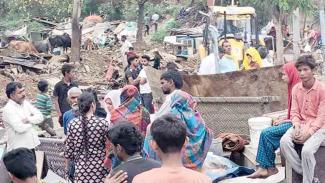February Demolitions
The work of the All-India Council of Trade Unions (AICCTU) amidst the ongoing housing crisis among Delhi’s working class has been documented extensively in previous issues of the Workers’ Resistance. The month of February witnessed the demolition of 30-40 tenements and constructed houses (two apartments’ buildings and around 10 individual houses) in Mehrauli. Large areas in Mehrauli are still under threat but due to pressure from political parties and trade unions, the Lieutenant Governor (LG) has temporarily stayed the demolitions.
While the temporary stay is a matter of relief for many, it is clear that the people whose houses are under threat remain quite uncertain about what the future has in store. The temporary relief has been possible by a combination of strategic litigation and hard political negotiations at local levels. Demolitions however continue across the country, including in Uttarakhand which witnessed a ‘successful’ anti-demolition protest recently at Banbhoolpura. Delhi is likely to see more bulldozing in the coming weeks.
In Delhi, it looks like the Delhi Master Plan 2041 is setting the stage for the demolitions. The plan appears as one that recognizes the “illegal” colonies and seeks to regularise them but in reality, it looks like their recognition is paving the way for demolitions. The limitations of the Plan in this regard were pointed out by experts and activists once the draft was circulated to the public. In an article published on 24 September 2021, Anusha Matam, Smriti Singh, and Sukrit Nagpal outlined a set of concerns which increasingly appear urgent.
Delhi Master Plan 2041
Matam, Singh, and Nagpal point out that the Plan indeed enlists two “improvement” schemes for unauthorised colonies aiming “to improve the quality of life of people living in unplanned areas”. The first scheme pertains to the “regeneration” of unauthorised colonies. It calls for fresh development requiring high monetary and technical investment. The scheme however ignores the prevalent high densities and compact built forms of many unauthorised colonies. The scheme also delegates the entire responsibility of regeneration to a Developer Entity, defined as “an individual land/property owner or a group of land/property owners who have pooled one or more parcels of land for taking up development/ regeneration”.
But what percentage of residents will constitute the Developer Entity? How will representation of vulnerable residents (such as marginalised caste groups, women owners, and small plot owners) be ensured? What form will this consent take? These questions find no answer in the plan.
The scheme is paving the way for gentrification and the possible displacement of vulnerable residents, the authors suggest. The scheme is prone to exploitation by developers and market forces, especially in areas where land value is high. Matam, Singh, and Nagpal also suggest that since the first scheme requires high financial and technical capacities, a majority of unauthorised colonies are likely to resort to the second scheme that details provisions for layout approvals of existing unauthorised colonies. Popularly referred to as the “as is scheme”, the norms proposed are too rigid to address the density and diverse urban morphology of the majority of Delhi’s unauthorised colonies, the authors argue.
For instance, the scheme proposes that all the plots should be within 30-metres distance from a 9-metre-wide road to adhere to conventional fire safety norms. Such requirements have been major roadblocks to regularisation attempts for several years. For dense colonies that have existed for over 50 years, this is unfeasible as it will require major adjustments in the built environment.
Land and Housing Rights as a Core Political Question
On the whole, the authors point out that together, a total of over 75% of so-called unauthorised colonies do not qualify for either of the two improvement schemes, effectively shutting the door for their “development”. Are the improvement provisions applicable merely for 25% of the area occupied by unauthorised colonies, they ask?
The connections between the Master Plan and the current demolitions need more investigation. As of now there is a need for a national coordination against bulldozer politics, and strong local solidarities, to stop the demolitions and to produce land and housing rights as a core political issue. That will also help to rebuild democratic politics by highlighting peoples’ issues, as opposed to the Hindu supremacist politics we see at present.
The right to adequate housing in a part of the international human rights law. This was recognized as part of the right to an adequate standard of living in article 25 of the 1948 Universal Declaration of Human Rights and in article 11.1 of the 1966 International Covenant on Economic, Social and Cultural Rights. The aggressive accumulation by state and capital at a time of increasing population pressure and climate change needs a political response. It can only come from democratic forces strongly oriented towards working class interests and against the state/capital nexus.









